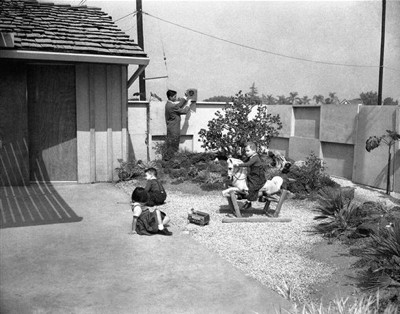Futurism
Raspberry Pi—The $25 Computer
Last week I described the Universal translator, which used two of these computers. Powered by a USB port, it has other ports for video display, storage and other great stuff.The really amazing part is that this working computer is only $25 plus shipping. There is a huge back-order for them, but some people are inventing creative ways to use this computer.

Some people are using them to feed their animals, create demonstrations or music boxes. Here's the link:
http://www.raspberrypi.org/
Others are busy creating containers for these tiny computers
Here's my favorite so far.

What new use for this mini-computer will you discover?
Posted By: gdanea - Mon Apr 29, 2013 -
Comments (12)
Category: Futurism
Arthur Clarke Predictions in 1974
In this clip from 1974, Arthur C. Clarke predicts the computer will taken as much for granted in our homes as a phone. (Still have a land-line?)As they are standing by the massive main-frame computers of the day, it reminded me how noisy they were.
How many correct predictions can you find?
Posted By: gdanea - Mon Apr 15, 2013 -
Comments (7)
Category: Futurism
Worst Failure to Predict Global Warming Ever!

Read the whole issue here.
Posted By: Paul - Wed Jan 09, 2013 -
Comments (3)
Category: Futurism, Magazines, Children, Science Fiction, 1980s
Jack Fletcher’s House of the Future
In 1954, 23-year-old Jack Fletcher showed off his new home to the media. Reporters called it the "house of the future" because of all the unique features he had designed into it. The windows closed by themselves when sensors felt rain. Lights came on automatically when someone entered a room. The phone had a speed-dial feature. The lamps didn't need cords. Instead you just placed them over induction coils installed in the floor. And strangest of all, electromagnets caused pots and pans to float over the stove (which also used induction coils to heat the food).The house was in West Covina, CA (in the LA area). I wonder if it's still standing? I don't see why it wouldn't be, but I haven't been able to find an address for it. Read more about it here and here.




Posted By: Alex - Fri Jul 06, 2012 -
Comments (9)
Category: Architecture, Buildings and Other Structures, Futurism
In the future, we’ll all be speaking Super Cockney
Almost 87 years have passed since this professor made his prediction. Is there any chance it might still come true?From the St. Petersburg Evening Independent, Nov. 25, 1924.

Posted By: Alex - Sat May 26, 2012 -
Comments (3)
Category: Futurism, Languages
Weird Science – Watch and Learn

Outside it is not much to look at, little more than a discoloured rock dredged up from the sea floor. But an x-ray scan of the object, actually a pocket watch recovered from a 17th century shipwreck, has revealed that the internal mechanism has been perfectly preserved. The computer aided tomography system used was sensitive enough to pick out the tiniest details, included the engraved name of the master watchmaker, one Niccholas Higginson of Westminster, London (Gizmodo).
As if more proof were needed that they don’t build them like they used to, a UK group has started collecting donations to build the first fully working version of Babbage’s “Analytical Engine”. The original design, dating from 1837, was never completed, possibly due to a combination of the strict engineering tolerances needed and Babbage’s notoriously prickly temperament. If the final machine works as advertised, it will be very strong confirmation of the claim that Babbage designed the first general purpose, programmable computer (BBC News).
Meanwhile, in Slovenia, Borut Povse and his team are busy teaching a modern descendant of Babbage’s design to hit people. Somehow Povse has convinced six volunteers to let an industrial robot hit them on the arm with various sharp or blunt implements in an effort to determine how much pain each blow causes. Obviously this has a beneficial use in that robots can be programmed not to exceed certain levels of force near a human obstacle, but will also be of immense interest to the machines during any future robot uprising (New Scientist).
Another robot out to supplant humans is HRP-4, a gynoid (female android), that has learnt to sing by copying the inflection and expressions of a human performer, right down to the breathing. The hope is to make robots behave in a more convincingly natural way, and so overcome the so called ‘uncanny valley’. From the video, it looks like they’ve still got a way to go (Daily Mail).
More in extended >>
Posted By: Dumbfounded - Fri Oct 22, 2010 -
Comments (5)
Category: Anthropomorphism, Beauty, Ugliness and Other Aesthetic Issues, Charities and Philanthropy, Futurism, History, Archaeology, Injuries, NGOs, Robots, Science, Technology
Weird Science – Yet More Robots
In a strange case of the left manipulator not knowing what the right manipulator is doing, here are two more robots that I somehow managed to miss off yesterday’s post.First up is the obvious and long overdue companion to yesterday’s beer fetching robots; a robot that can flip pancakes. Obviously there have been automated pancake makers around for a while now, but this robot from the Italian Institute of technology has learnt how to flip a good pancake by seeing how humans do it. Please, Dr. Kormushev, teach it to fry bacon next (Vimeo).
But if some groups are concentrating on robots that ply you with beer and pancakes, Autom’s mission in life is to help you lose weight and live healthily. The brainchild of Cory Kidd, who had the idea while at MIT, Autom first asks you for details of your diet, fitness and exercise regime, then it has daily 'conversations' with you during which it will dispense diet and exercise advice. Apparently a major insurance company intends to trial Autom in the US sometime next year, so we can all look forward to having one of these nag us each morning as a mandatory requirement of our health plan (Engadget).
Hmm, perhaps I could teach the pancake robot to flatten the annoying little thingamajig with its frying pan before making my breakfast stack?
Posted By: Dumbfounded - Fri Jul 23, 2010 -
Comments (5)
Category: Exercise and Fitness, Futurism, Health, Inventions, Robots, Technology
Weird Science – Invention Is The Mother Of Necessity
Build a better mousetrap, it is said, and the world will beat a path to your door. The implication being that there are some problems which are just crying out for a solution. And then there are the solutions crying out for a problem - those inventions that, while inspired, are just a tad “out there”. It is this later category I shall be celebrating today.First up, how clean is your cow? This age old problem has nagged at the minds of farmers down the ages, are their cows clean enough? And why isn’t there an easier way to clean cows? Well these merchants of the soil need worry no more thanks to a Swedish company that has developed the fully automated “cow wash”. Supposedly improving the health and yield of cows that use it, the cow wash uses a free swinging revolving brush to groom the cows while simultaneously stimulating their circulation. Apparently the cows enjoy using it and the makers DeLaval have sold over 30,000 in Sweden alone (Daily Mail).
Bigwigs in the US military will also soon be able to sleep sounder in the knowledge that the men under their command are safely in their underpants. We’re not just talking about any undies though, these have been specially designed by University of California professor Joseph Wang. Not only will his techno-trunks monitor the vitals of the personnel wearing them, they can even administer painkillers or antibiotics as the situation demands (Post Chronicle).
And if your pants don’t save you, at least your modesty will be preserved when you are taken to hospital, all thanks to the University of Montreal. For it is from that fine establishment’s School of Industrial Design that our next invention hails, a hospital gown that isn’t quite so revealing. The DUO gown is the brainchild of Noemie Marquis and Denyse Roy and consists of two overlapping panels, front and back, that is easy to put on and requires no fasteners making life simpler for both patients and staff (Medical News Today).
Meanwhile British scientists have been working on an altogether sterner cover. Nicknamed “bullet-proof custard” by its inventors, Bristol based BAE systems have developed a liquid armour consisting of layers of Kevlar combined with a secret “shear-thickening” liquid that hardens as force is applied. The company’s eventual aim is to produce lighter, more-flexible body armour for the military (BBC News).
More in extended >>
Posted By: Dumbfounded - Thu Jul 22, 2010 -
Comments (9)
Category: Animals, Farming, Bicycles and Other Human-powered Vehicles, Futurism, Hospitals, Inventions, Robots, Science, Technology, Underwear
Weird Science - Towel Folding Robot
Judging by the huge response to what I thought was a fairly large and obscure post about a tiny coincidence, the Hitchhiker's Guide and cutting-edge science is obviously a winning combination.So here is a super special Douglas Adams bonus, a robot folding towels! Okay so that's a bit of a stretch, but it is still quite cool.
Note that this video has been speeded up 50x, in real time it took the robot over an hour and a half to complete this one task. Perhaps it was feeling a little depressed?
Posted By: Dumbfounded - Sat Apr 17, 2010 -
Comments (25)
Category: Boredom, Futurism, Inventions, Robots, Science, Experiments, Technology
The Cashless Society, As Predicted In 1967.
Here's a clip from the BBC popular science program Tomorrow's World from 1967, talking about how the future will become a cashless society. It's interesting to see that the very first debit-card system shown on the program used PINs rather than signatures to authorize.Unfortunately, the BBC iPlayer can't be embedded like most online videos, so here's a link to the excerpt in question.
http://www.bbc.co.uk/archive/tomorrowsworld/8012.shtml
This is just one of a number of Tomorrow's World clips the BBC is making freely available online. There are some real gems on the site, including a first look at the "light-pen" from 1967, an early screen outing for the Moog synthesizer from 1969, and a demonstration of one of the first true mobile phone systems from 1979.
http://www.bbc.co.uk/archive/tomorrowsworld/index.shtml
Oops, it seems not everyone can view the Online BBC Archive. For those who can't here's a couple of stills from the electronic banking and mobile phone segments mentioned above.


Love that funky retro dial! :lol:
Posted By: Dumbfounded - Mon Sep 14, 2009 -
Comments (3)
Category: Futurism, Television, 1960s

| Who We Are |
|---|
| Alex Boese Alex is the creator and curator of the Museum of Hoaxes. He's also the author of various weird, non-fiction, science-themed books such as Elephants on Acid and Psychedelic Apes. Paul Di Filippo Paul has been paid to put weird ideas into fictional form for over thirty years, in his career as a noted science fiction writer. He has recently begun blogging on many curious topics with three fellow writers at The Inferior 4+1. Contact Us |




